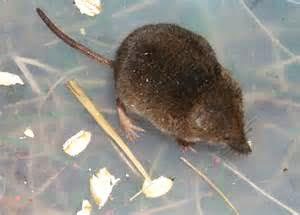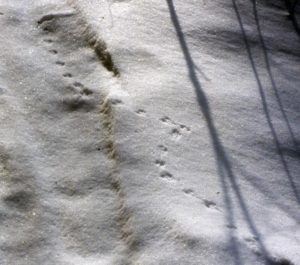Shrews
by Linda Spielman

Sometimes small things don’t get the attention they deserve, and this is certainly the case with the shrew. Much more numerous than most of us realize, these tiny creatures inhabit woodlands, meadows, old fields, hedgerows, swamps, and riparian zones, and in some locations they make up a larger fraction of the total biomass than any other single species. Actually our area hosts three different shrews: the masked shrew, the smokey shrew, and the short-tailed shrew. Weights range from as little as a tenth of an ounce for the masked shrew to a maximum of eight tenths of an ounce for the short-tailed shrew. The smallest shrews can enter openings just a half inch across.
Shrews are voracious predators, consuming insects, insect larvae, earthworms, and other invertebrates, salamanders, snakes, and even voles and mice. Most of their prey is found in the leaf litter or in the soil, so shrews spend much of their time hidden under the leaves or below the soil surface. If you can find a comfortable place in the woods where there is plenty of leaf litter, try sitting quietly for a while. You might hear the rustling of tiny shrew bodies pushing their way through the leafy debris searching for beetles, pillbugs, millipedes, slugs, snails, and other juicy (to a shrew) tidbits. They also tunnel through the soil probing for edible items. Mice and voles provide meals for the larger species, the short-tailed shrew and the smokey shrew. The short-tailed shrew has a special advantage: its toxic saliva is injected when it bites its prey. And shrews also have the ability to find their way in dark subterranean spaces by echolocation. The petite predators travel the tunnels and passageways created by their prey and sometimes manage to subdue animals that weigh several times more than they do.

Shrews have high metabolic rates and must eat anywhere from 50 to 150% of their body weight every day—they can survive only a few hours without eating. When insects are on the menu, a shrew makes many short hunting forays, each one lasting just a few minutes and followed by a ten or fifteen minute rest period. A large item like a vole provides many meals and is usually cached for future use. The shrew returns repeatedly for short feeding bouts followed by rest periods. These rest periods apparently help the feisty little animal to conserve some of its energy, but it’s never very long before hunger spurs the shrew to renew the search for food.
Shrews are active year-round, tunneling as deep as 20 inches below the soil surface in cold weather. And accumulating winter snow may actually be beneficial. Snow is an excellent insulator, and a deep, dry snowpack can keep temperatures at ground level 40 degrees or more above air temperature. The gradient of temperature from the relatively warm ground to the colder upper parts of the snowpack causes ice crystals to migrate upwards. Cavities and openings are created in the lower parts of the snowpack which easily accommodate small mammals lik e shrews.
e shrews.
With access to such an ideal subnivean environment, it’s a wonder that shrews ever come out on the snow surface. After all, on the surface they are exposed to predators like owls, hawks, foxes, weasels and coyotes. But in spite of the danger, shrews do leave evidence of their occasional presence on the snow surface. On my snowshoe wanderings in the forests of Hammond Hill I’ve often found trails like the one in the photo. The bounding pattern may remind you of a mouse or vole trail, but the size—less than an inch and sometimes as little as ½ inch across at the widest point—is much too small for either a mouse or a vole. I suspect that the emergence of shrews onto the snow surface may have something to do with icy layers or blockages below the surface that prevent the creatures from getting where they want to go. And once a shrew is out on top of the snow, it may take some searching before it finds a way back down. Most of the time the trails end at small holes or openings under protruding branches, telling us that the tiny wanderer did return to the safe caverns and passageways below.
